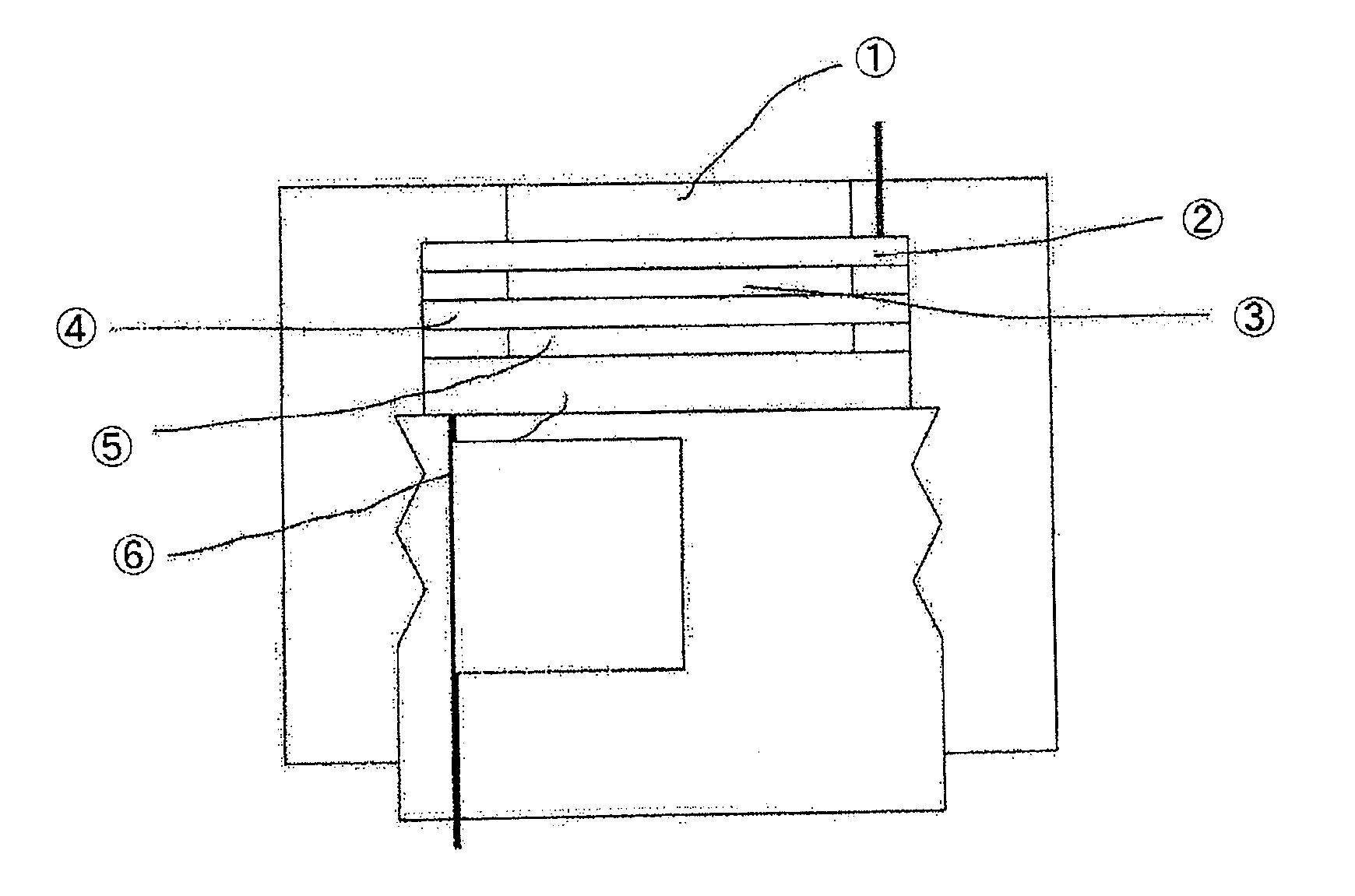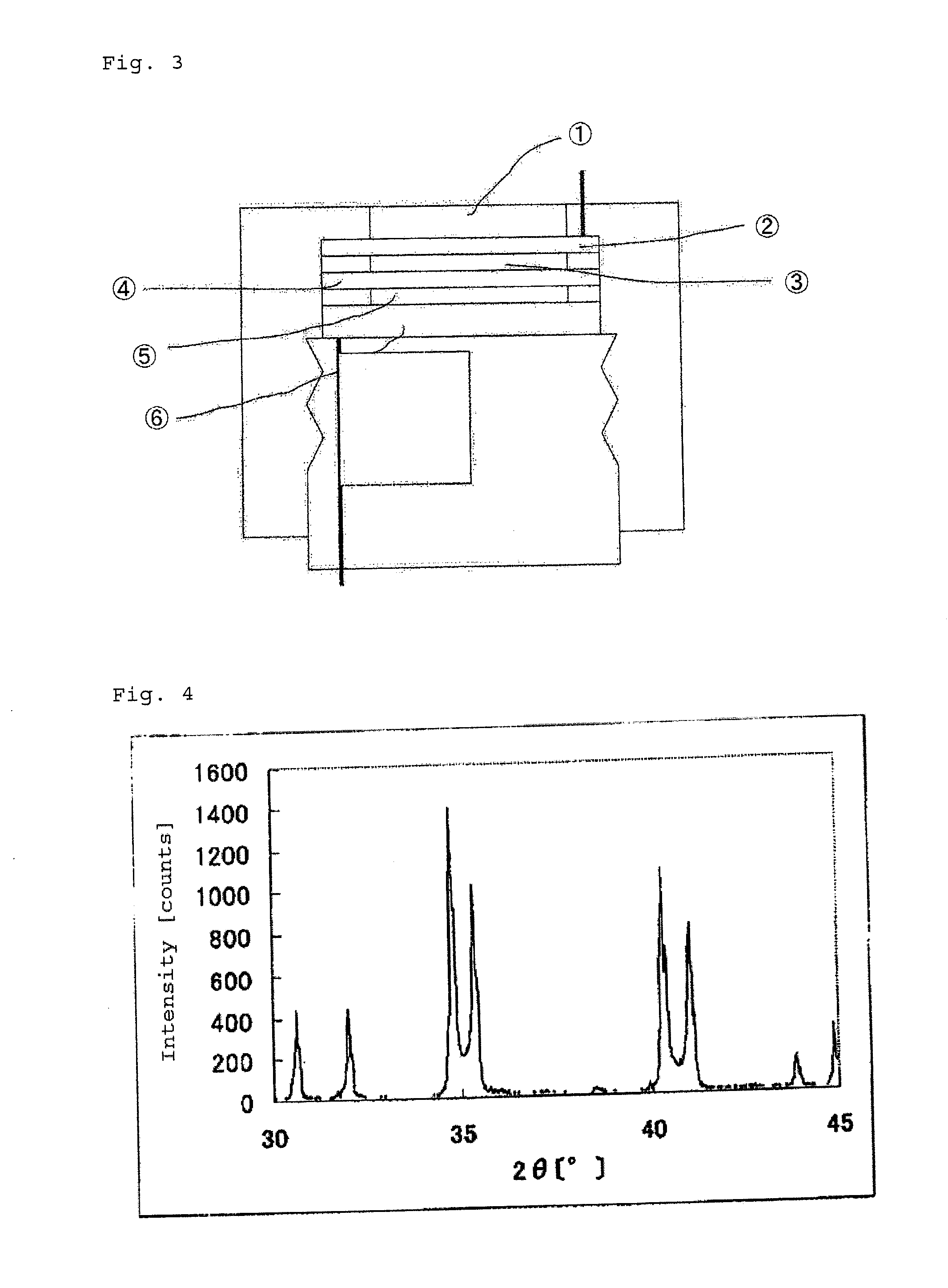Air battery catalyst and air battery using the same
- Summary
- Abstract
- Description
- Claims
- Application Information
AI Technical Summary
Benefits of technology
Problems solved by technology
Method used
Image
Examples
example 1
1. Preparation of Catalyst
[0127]Niobium (IV) oxide (NbO2) weighing 2.50 g (20 mmol) and 600 mg (50 mmol) of carbon (Vulcan 72 manufactured by Cabot Corporation) were sufficiently crushed and mixed together. The resultant powder mixture was heated in a tubular furnace in a nitrogen atmosphere at 1600° C. for 1 hour to give 2.54 g of niobium carbonitride.
[0128]FIG. 1 shows an X-ray powder diffraction spectrum of the niobium carbonitride.
[0129]The niobium carbonitride in an amount of 1.00 g was heated in a tubular furnace at 800° C. for 1 hour while passing an argon gas containing 1% by volume of oxygen gas. As a result, 1.08 g of niobium oxycarbonitride (hereinafter, also referred to as the catalyst (1)) was obtained.
[0130]FIG. 2 shows an X-ray powder diffraction spectrum of the catalyst (1). The spectrum was in agreement with that of Nb12O29. The BET specific surface area of the catalyst (1) was 2.2 m2 / g.
[0131]The elemental analysis of the catalyst provided the following molar ratio....
example 2
1. Preparation of Catalyst
[0143]Niobium (IV) oxide (NbO2) weighing 4.95 g (39.6 mmol), tin (IV) oxide (SnO2) weighing 60 mg (0.4 mmol) and carbon (Vulcan 72 manufactured by Cabot Corporation) weighing 1.2 g (100 mmol) were sufficiently crushed and mixed together. The resultant powder mixture was heat treated in a tubular furnace in a nitrogen atmosphere at 1400° C. for 3 hours to give 4.23 g of carbonitride (2) containing tin (0.01 mol per mol of niobium) and niobium.
[0144]The carbonitride (2) in an amount of 1.02 g was heat treated in a rotary tubular furnace at 800° C. for 1 hour while passing an argon gas containing 1% by volume of oxygen gas and 2% by volume of hydrogen gas. As a result, 1.10 g of oxycarbonitride containing tin (1 mol %) and niobium (hereinafter, also referred to as the catalyst (2)) was obtained. The results of the elemental analysis of the catalyst (2) are described in Table 1.
[0145]FIG. 4 shows an X-ray powder diffraction spectrum of the catalyst (2). Four di...
example 3
1. Preparation of Catalyst
[0150]Niobium carbide weighing 5.88 g (56 mmol), ferric oxide weighing 0.40 g (2.5 mmol) and niobium nitride weighing 5.14 g (48 mmol) were sufficiently crushed and mixed together. The resultant powder mixture was heat treated in a tubular furnace in a nitrogen atmosphere at 1600° C. for 3 hours to give 11.19 g of carbonitride (3) containing iron and niobium. The sintered carbonitride (3) was crushed in a ball mill.
[0151]The carbonitride (3) in an amount of 1.00 g was heat treated in a tubular furnace at 900° C. for 6 hours while passing a nitrogen gas containing 1% by volume of oxygen gas and 0.8% by volume of hydrogen gas. As a result, 1.24 g of oxycarbonitride containing iron (0.02 mol per mol of niobium) and niobium (hereinafter, also referred to as the catalyst (3)) was obtained.
[0152]FIG. 5 shows an X-ray powder diffraction spectrum of the catalyst (3). Four diffraction peaks were observed at diffraction angles 2θ of 33° to 43°.
[0153]The elemental ana...
PUM
| Property | Measurement | Unit |
|---|---|---|
| Crystal structure | aaaaa | aaaaa |
Abstract
Description
Claims
Application Information
 Login to View More
Login to View More - R&D
- Intellectual Property
- Life Sciences
- Materials
- Tech Scout
- Unparalleled Data Quality
- Higher Quality Content
- 60% Fewer Hallucinations
Browse by: Latest US Patents, China's latest patents, Technical Efficacy Thesaurus, Application Domain, Technology Topic, Popular Technical Reports.
© 2025 PatSnap. All rights reserved.Legal|Privacy policy|Modern Slavery Act Transparency Statement|Sitemap|About US| Contact US: help@patsnap.com



